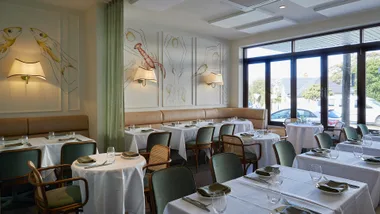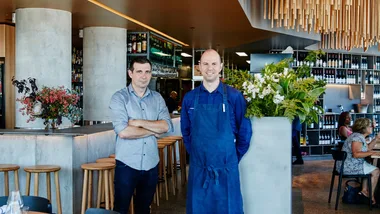Dim sum master Mak Kwai Pui brings celebrated dumpling house Tim Ho Wan to Australia this month.
If you pride yourself on knowing your cheong fun from your zhaliang, chances are you’re familiar with Tim Ho Wan. The Hong Kong dim sum restaurant found international renown when its original Mong Kok branch débuted in the 2010 edition of the Michelin Guide as the cheapest starred restaurant in the world. Since then, the brand has grown to three outlets in Hong Kong, with satellites in Singapore, Hanoi, Taipei, Kuala Lumpur and Manila. The big news is that Sydney is going to be the next city to taste the magic, and the Chatswood branch opening this month will be the first Tim Ho Wan outside Asia.
The Sydney CBD and Burwood are to follow, as will a branch in Melbourne’s Chinatown.
The man behind the phenomenon is Mak Kwai Pui, an alumnus of the kitchens at Lung King Heen (the first Cantonese restaurant in the world to win three stars) and a chef whose focus on fresh ingredients and proper technique has propelled Tim Ho Wan to international acclaim. We caught up with chef Mak to talk Australia, dim sum excellence and more.
GT: When you opened Tim Ho Wan, did you imagine it would end up being such a phenomenon?
Mak Kwai: No, my first intention of opening Tim Ho Wan was to share quality traditional dim sum with my community at an affordable price. I chose to open in Sham Shui Po because it’s the old district I grew up in. We used to have many authentic Cantonese eateries in the neighbourhood, but the food scene was changing. We are now living in a global village, influenced by many other cuisines. It’s the trend for the little restaurants and food stalls in Sham Shui Po to sell a variety of cuisine types – Korean barbecue, Thai chicken rice, Turkish skewers, and so on – but less and less authentic Hong Kong flavours, which made me want to do something about it.
Why Australia for your first outlet outside Asia?
Since the 1990s many outstanding Hong Kong chefs have migrated to Australia and they’ve introduced fine Chinese cuisine to Australians. Australians know the standard of authentic dim sum well. When we opened the first Tim Ho Wan in Hong Kong, the first international media that visited and interviewed me were Australian, so I kept feeling that there was some kind of connection and that I should come to Australia.
What do you know of the Australian food scene?
Australia has very high culinary standards; there are many authentic Chinese restaurants in Sydney and Melbourne. The food scene should be quite interesting – there are many good Australian chefs and they are very innovative in melding Asian flavours into Western cooking methods. I’m ready to explore more when we start the business in Sydney.
What are Australians like as customers?
They know the value of fine food and their expectations of quality are high. They’re more adventurous in trying new tastes compared to people from other countries.
What’s the secret of your success?
Being a dim sum chef since the age of 16, I was trained to work hard over long hours. I’m doing what I’m good at, and I’ve planned my business based on more than 30 years’ experience in the restaurant industry. I’ve made many chef friends along the way and we share the same business goal: to share quality traditional dim sum with the community at a fair price. Now these friends are my good partners in different branches. Partnership is important to me.
Which dishes do you order to test a kitchen?
The siu mai. This is the easiest dim sum dish served across all of the restaurants, but it also takes a lot of skill to make it outstanding.
What about judging the overall quality of dim sum – what do you look for?
The freshness of ingredients. Unlike deep-fried or heavily marinated food, you can’t hide if the ingredients aren’t fresh in dim sum. Then there’s the skill of dim sum making – dim sum is always purely handmade; there is no machine to replace the skill. The words dim sum in Chinese also translate as “a little bit of heart”, so customers should be able to tell from the taste if the chef who made the dim sum did it with heart. It’s the beauty of dim sum which customers should appreciate.
Illustration Lauren Haire










